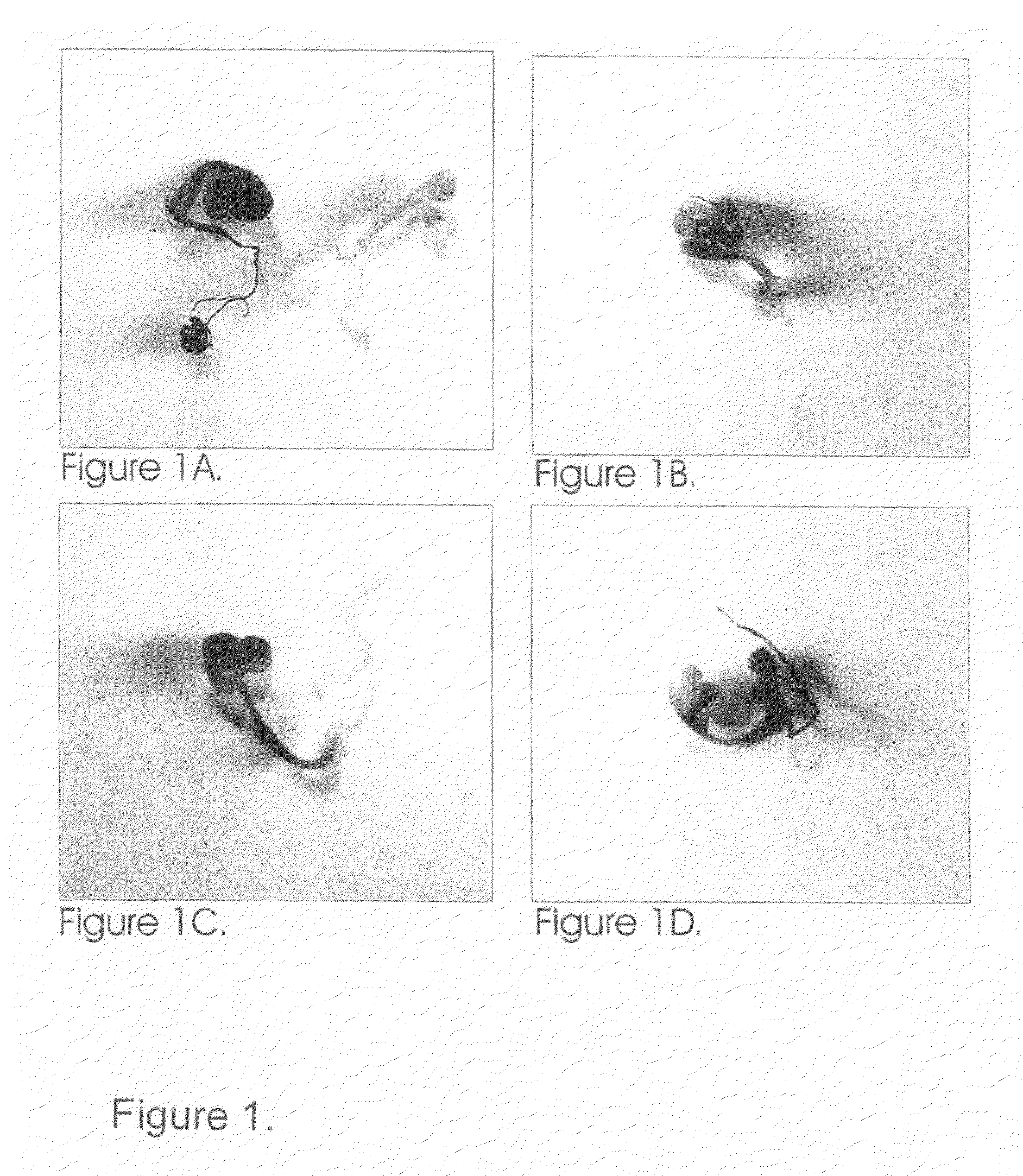Process for converting storage reserves of dicotyledonous seeds into compositions comprising one or more gene products
a technology of dicotyledonous seeds and dicotyledonous seeds, which is applied in the direction of plant genotype modification, fermentation, biochemistry apparatus and processes, etc., can solve the problems of inability to express heterologous proteins, small protein content of tobacco leaf, and inability to achieve therapeutic mammalian proteins, etc., to achieve good storability and facilitate conjugation of gene products
- Summary
- Abstract
- Description
- Claims
- Application Information
AI Technical Summary
Benefits of technology
Problems solved by technology
Method used
Image
Examples
example 1
GUS Gene Expression in Germinating Brasssica campestris Seeds
[0106]GUS expression is demonstrated with a histochemical assay. We used four different promoters to regulate the GUS expression. The promoters used are Soybean heat shock promoter, Vigna mungo endopeptidase promoter, Nicotiana tabacum pr-promoter and CaMV 35S promoter. Promoter sequences were produced by PCR with plant total DNA as a template.
[0107]The promoters were linked to the GUS gene using NcoI enzyme. The promoter-GUS constructs were cloned in a plant transformation vector, pGPTV-hpt (Becker et al. 1992. Plant Mol. Biol. 20:1195-97). B. campestris was transformed according to the protocol described by Kuvshinov, V. et al. (Plant Cell Reports 18:773-777, 1999). The transgenic plants were grown in greenhouse until they produced seeds. The transgenic seeds were germinated and used for the histochemical GUS assay. The results are shown in FIGS. 1-3.
[0108]On the left side in FIG. 1A a germinated seed of a transgenic B. ...
example 2
Storage Proteins are Converted to Rubisco Proteins in Developing Sprouts
[0114]Brassica campestris seeds were germinated for 12-168 hours in an airlift tank (shown in FIG. 10). The total proteins were extracted and separated by 15% SDS-PAGE. The gel was stained with Coomassie blue. Between 36 and 60 hours, the degradation of storage proteins and de novo synthesis of Rubisco was clearly visible. This result is illustrated in FIG. 6. Similarly, FIG. 5 illustrates germination experiment with Brassica rapa (campestris) seeds. The amount of Rubisco proteins is clearly increased after the third day.
[0115]FIG. 7A illustrates Northern blots showing synthesis of Rubisco SSU mRNA after 24-26 hours of sprouting in an airlift tank. Total RNA was isolated from spouts germinated form 12-168 hours. FIG. 7B shows unlabelled Rubisco RNA produced by in vitro transcription as loaded as a control.
[0116]FIG. 4 shows a SDS-PAGE gel of germinated Brassica campestris seeds. The samples were collected daily,...
example 3
The Preparation of Novel rbcS-Promoters for the Expression System
[0118]Based on the strong Rubisco protein synthesis in germinating seeds it seems that Rubico promoter is a very strong promoter in rapeseed sprouts. Therefore, we decided to characterize Rubisco promoters in the germinating seeds and characterize the promoters further.
[0119]A cDNA library was constructed in order to identify the most abundant types of Rubisco mRNA to be expressed in cotyledons of germinating Brassica rapa (campestris) seeds.
[0120]Total RNA was isolated from four days old Brassica seedlings, and a mRNA fraction was isolated from the total RNA preparations using oligo(d)T cellulose. A first strand cDNA was synthesized using oligo(d)T with M-MLV (Point mutant) reverse transcriptase. The next PCR step was carried out with a forward primer e3a 5′-CAUCAUCAUCAUCAACCGTCAAGTCCAGTGCATCAGTTTCAT-3′ (SEQ ID NO: 4) specific to the 3rd exon of Rubisco SSU coding region and the reverse primer atu 5′-CUACUACUACUATTTTT...
PUM
| Property | Measurement | Unit |
|---|---|---|
| time | aaaaa | aaaaa |
| temperatures | aaaaa | aaaaa |
| temperatures | aaaaa | aaaaa |
Abstract
Description
Claims
Application Information
 Login to view more
Login to view more - R&D Engineer
- R&D Manager
- IP Professional
- Industry Leading Data Capabilities
- Powerful AI technology
- Patent DNA Extraction
Browse by: Latest US Patents, China's latest patents, Technical Efficacy Thesaurus, Application Domain, Technology Topic.
© 2024 PatSnap. All rights reserved.Legal|Privacy policy|Modern Slavery Act Transparency Statement|Sitemap



